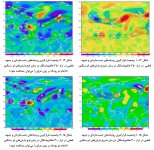درود و سپاس از بابت پاسخ بسيار بهره بردم :گل:
August 20, 2014
ENSO forecast: Our SINTEX-F model still shows that the weak El Niño condition will continue and mature in late boreal fall and early winter. However, the simultaneous El Niño Modoki signature will become relatively prominent in early next year.
Indian Ocean forecast: The negative IOD will mature in fall and change into a basin-wide mode in late boreal fall/winter, possibly due to the capacitor effect of either the Pacific El Nino or the El Nino Modoki
Regional forecast: Most parts of Europe, Africa, Middle East, Russia, India, Southeastern Asia, South American Continent, western U.S., Mexico, and the Far East including Japan will experience a warmer-than-normal condition in September. On the other hand, South Africa, central China, southern Australia, central-eastern U.S. will be in a colder-than-normal condition in September.
In boreal fall, most parts of Europe, Africa, Middle East, eastern/western Russia, India, Southeast Asia, South American Continent, western/eastern U.S., Mexico, Australia and the Far East including Japan will be in a warmer-than-normal condition owing to the development of El Nino, whereas central Russia, South Africa and central U.S. will be in a colder-than-normal condition.
The Maritime Continent (except for Sumatra), India, northeastern Australia, Caribbean countries, and East Africa will be in a drier-than-normal condition in boreal fall owing to the development of El Nino and negative IOD. On the other hand, a wetter-than-normal condition is predicted for eastern China and U.S. In particular, the wetter-than-normal condition in California will be associated with the warmer-than-normal SST of the newly identified phenomenon “California Nino”.
August 20, 2014
ENSO forecast: Our SINTEX-F model still shows that the weak El Niño condition will continue and mature in late boreal fall and early winter. However, the simultaneous El Niño Modoki signature will become relatively prominent in early next year.
Indian Ocean forecast: The negative IOD will mature in fall and change into a basin-wide mode in late boreal fall/winter, possibly due to the capacitor effect of either the Pacific El Nino or the El Nino Modoki
Regional forecast: Most parts of Europe, Africa, Middle East, Russia, India, Southeastern Asia, South American Continent, western U.S., Mexico, and the Far East including Japan will experience a warmer-than-normal condition in September. On the other hand, South Africa, central China, southern Australia, central-eastern U.S. will be in a colder-than-normal condition in September.
In boreal fall, most parts of Europe, Africa, Middle East, eastern/western Russia, India, Southeast Asia, South American Continent, western/eastern U.S., Mexico, Australia and the Far East including Japan will be in a warmer-than-normal condition owing to the development of El Nino, whereas central Russia, South Africa and central U.S. will be in a colder-than-normal condition.
The Maritime Continent (except for Sumatra), India, northeastern Australia, Caribbean countries, and East Africa will be in a drier-than-normal condition in boreal fall owing to the development of El Nino and negative IOD. On the other hand, a wetter-than-normal condition is predicted for eastern China and U.S. In particular, the wetter-than-normal condition in California will be associated with the warmer-than-normal SST of the newly identified phenomenon “California Nino”.







